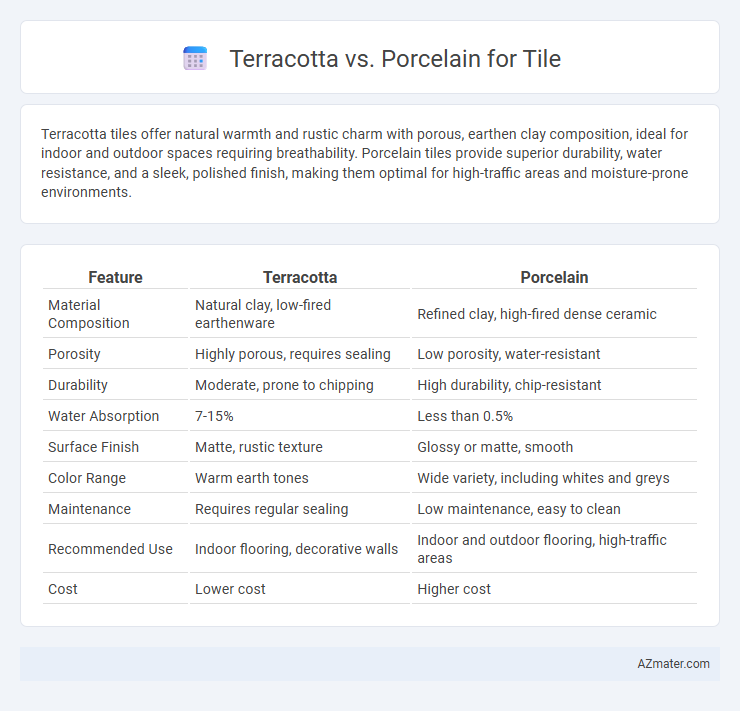Terracotta tiles offer natural warmth and rustic charm with porous, earthen clay composition, ideal for indoor and outdoor spaces requiring breathability. Porcelain tiles provide superior durability, water resistance, and a sleek, polished finish, making them optimal for high-traffic areas and moisture-prone environments.
Table of Comparison
| Feature | Terracotta | Porcelain |
|---|---|---|
| Material Composition | Natural clay, low-fired earthenware | Refined clay, high-fired dense ceramic |
| Porosity | Highly porous, requires sealing | Low porosity, water-resistant |
| Durability | Moderate, prone to chipping | High durability, chip-resistant |
| Water Absorption | 7-15% | Less than 0.5% |
| Surface Finish | Matte, rustic texture | Glossy or matte, smooth |
| Color Range | Warm earth tones | Wide variety, including whites and greys |
| Maintenance | Requires regular sealing | Low maintenance, easy to clean |
| Recommended Use | Indoor flooring, decorative walls | Indoor and outdoor flooring, high-traffic areas |
| Cost | Lower cost | Higher cost |
Introduction to Terracotta and Porcelain Tiles
Terracotta tiles are crafted from natural clay, fired at lower temperatures, resulting in porous, warm-toned tiles with an earthy, rustic aesthetic ideal for traditional and Mediterranean-style spaces. Porcelain tiles undergo a more intense firing process and are made from refined clay mixtures, producing dense, durable, and moisture-resistant surfaces suitable for high-traffic and contemporary environments. Both tile types offer distinct characteristics in texture, durability, and maintenance, making informed selection crucial for specific design and functional needs.
Material Composition: Terracotta vs Porcelain
Terracotta tiles are made from natural clay baked at lower temperatures, resulting in a porous, slightly rough texture that offers a warm, rustic aesthetic. Porcelain tiles consist of finely ground clay mixed with other minerals, fired at higher temperatures, producing a dense, hard, and less porous surface with enhanced durability and water resistance. The material composition differences directly influence their performance, with terracotta being more suited for indoor, low-moisture areas, while porcelain excels in high-traffic, wet environments.
Aesthetic Differences: Color and Texture
Terracotta tiles exhibit warm, earthy tones ranging from deep reds to soft browns, featuring a naturally porous, rustic texture that adds character and charm to spaces. Porcelain tiles offer a wider color spectrum, including bold, vibrant hues and sleek, polished finishes, with a smooth, dense surface that enhances modern and clean aesthetics. The contrast in color depth and tactile feel between terracotta and porcelain significantly influences design choices, catering to either traditional warmth or contemporary sophistication.
Durability and Strength Comparison
Terracotta tiles, made from natural clay fired at lower temperatures, offer moderate durability but are more porous and prone to chipping compared to porcelain. Porcelain tiles are denser and fired at higher temperatures, resulting in superior strength, resistance to scratches, and enhanced longevity for both indoor and outdoor applications. For high-traffic areas requiring long-lasting performance, porcelain is generally the preferred choice due to its robustness and low water absorption rate.
Water Absorption and Porosity
Terracotta tiles exhibit higher water absorption rates, typically ranging from 10% to 20%, due to their porous nature, making them more susceptible to moisture damage and staining. Porcelain tiles have significantly lower water absorption rates, often below 0.5%, resulting in superior resistance to water penetration and enhanced durability in wet environments. The difference in porosity between terracotta and porcelain directly influences their suitability for different applications, with porcelain favored for areas exposed to high moisture.
Maintenance and Cleaning Requirements
Terracotta tiles require regular sealing to prevent stains and moisture absorption due to their porous nature, making maintenance more intensive compared to porcelain. Porcelain tiles boast a dense, non-porous surface that resists staining and water infiltration, allowing for easier cleaning with standard household detergents and minimal upkeep. The durability of porcelain makes it ideal for high-traffic areas where low-maintenance solutions are essential.
Indoor vs Outdoor Suitability
Terracotta tiles offer natural porousness and rustic charm, making them ideal for indoor spaces where moderate humidity and foot traffic prevail, but they require sealing for outdoor use to prevent moisture damage. Porcelain tiles exhibit high density and low water absorption, granting superior durability and frost resistance suitable for both indoor and harsh outdoor environments. The choice depends on environmental exposure: porcelain withstands outdoor elements better, while terracotta enhances interior aesthetic with warm, earthy textures.
Cost Considerations: Budgeting for Tiles
Terracotta tiles typically offer a lower upfront cost compared to porcelain, making them a budget-friendly option for rustic or traditional aesthetics. Porcelain tiles, while more expensive initially, provide greater durability and lower maintenance costs over time, potentially reducing long-term expenses. When budgeting for tiles, consider terracotta's affordability against porcelain's resilience and longevity to ensure the best value for your investment.
Environmental Impact and Sustainability
Terracotta tiles are made from natural clay, requiring lower energy for production and offering biodegradability, which contributes to a smaller carbon footprint compared to porcelain. Porcelain tiles, though more energy-intensive to manufacture due to higher firing temperatures, provide exceptional durability and longevity, reducing the need for frequent replacements and thus minimizing long-term environmental impact. Both materials support sustainable practices when sourced responsibly, but terracotta's low-impact extraction and biodegradability often make it a more eco-friendly choice for environmentally conscious projects.
Choosing the Right Tile for Your Space
Terracotta tiles offer a warm, rustic charm with natural earthy tones and excellent breathability, making them ideal for outdoor patios and Mediterranean-style interiors, while porcelain tiles provide superior durability, low water absorption, and a wide range of finishes suitable for high-traffic areas and modern designs. Choosing the right tile depends on the intended use, environmental conditions, and aesthetic preferences, with terracotta excelling in dry, low-moisture settings and porcelain preferred for bathrooms, kitchens, and commercial spaces due to its resistance to stains and wear. Consider factors like maintenance requirements, slip resistance, and installation complexity to ensure long-lasting performance and style compatibility in your space.

Infographic: Terracotta vs Porcelain for Tile
 azmater.com
azmater.com